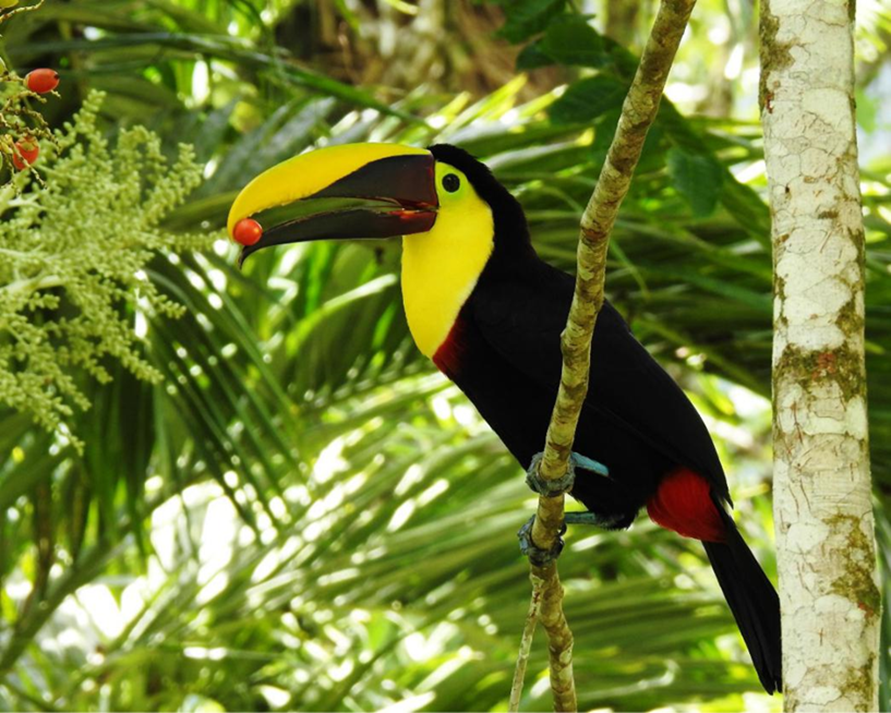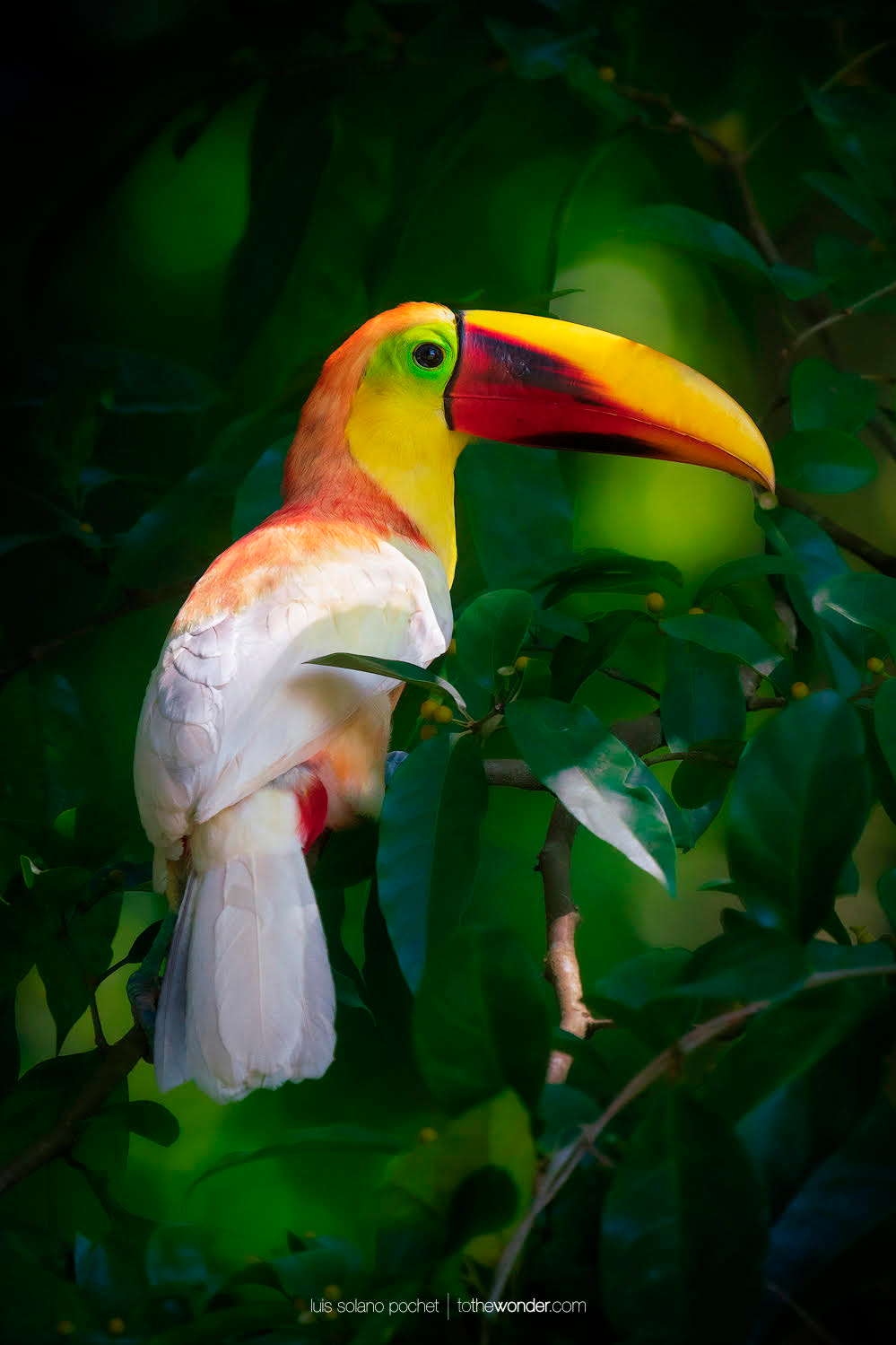Introduction
Toucans (Ramphastidae) are a very striking group of birds, brightly colored with a very large beak. The family is comprised of about 50 species with a distribution restricted to Central and South America (Guimarães Santos and Sousa De Paula 2019). The Yellow-throated Toucan (Ramphastos ambiguus) is predominantly black, and has feathers with brown tips, a yellow bib covering the throat and chest, and red under the tail coverts. Feathers above the tail are cream colo red (Figure 1). This toucan also has a red band countering the yellow bib. The skin of the face is chartreuse (Stiles and Skutch 1995). The Yellow-throated Toucan is most notable for its massive, bicolored bill (Rice et al. 2010). The beak measures approximately 18 cm long, and is slightly shorter in the female, with a black line around the base (Rice et al. 2010). It is yellowish at the culm, becoming wider distally, with a blackish brown triangle on the rest of the maxilla and on the jaw, sometimes with brown visible near the base (Stiles and Skutch 1995). Sexes are similar in color, but the male is larger with an average of 56 cm in length (females average 52 cm); it weighs between 580 and 750 g (Stiles and Skutch 1995).

Figure 1 A Yellow-throated Toucan (Ramphastos ambiguus) with normal coloration in the tropical wet forest on the Caribbean slope of Costa Rica (photo: José Manuel Mora).
The Yellow-throated Toucan occurs from southeastern Honduras to western Ecuador, and again from western Vene zuela to Peru (Rice et al. 2010). It is largely frugivorous, but like other toucans, occasionally feeds on insects, lizards, snakes and the eggs and chicks of other birds (Stiles and Skutch 1995). It is classified as near threatened (BirdLife International 2016). The species inhabits tropical lowland rainforests and foothills, adjacent tall secondary growth, and semi-open areas (Stiles and Skutch 1995, Garrigues and Dean 2014). In general, toucans prefer to occupy the canopy and are typically seen in pairs or in small flocks of up to six birds (Stiles and Skutch 1995).
There are several types of color aberrations known in birds, and most are caused by genetic mutations (Van Grouw 2013, Van Grouw 2018). The most prevalent pigmentary abnormality among birds is progressive greying (Van Grouw 2013). Leucism and albinism are also commonly reported, but the majority of these cases are, in fact, erroneously reported (Mahabal et al. 2016). In leucistic birds, the affected feathers completely lack melanin, appearing white (Van Grouw 2013). Most forms of progressive greying do not appear to be heritable, and are likely environmentally derived, whereas leucism is always heritable (Van Grouw 2013). Some cases reported as leucism are actually ino (Van Grouw 2013). In ino, there is a strong qualitative reduction of melanin resulting in a very pale plumage color and almost colorless skin; the plumage whitens further over time due to exposure to sunlight, and can become almost totally white (Van Grouw 2013, Mahabal et al. 2016). Albinism is a heritable mutation that causes the absence of the enzyme tyrosine, which is necessary for the production of melanin (Van Grouw 2013). In summary, even though plumage color aberrations are common in birds, there is much confusion in the literature among types of aberrations, especially of white birds (Guay et al. 2012).
Chromatic aberration has been reported in a large number of bird families (Ayala-Pérez et al. 2016). However, other than a few recent reports, publications about sightings of pigmentary abnormalities of birds in Costa Rica are scarce (Mora and López 2019). No reports exist regarding color aberration in toucans in Costa Rica.
Record
A Yellow-throated Toucan with abnormal coloration for the species (Figure 2) was observed at La Unión, Guápiles, Costa Rica (10°12’N, 83°52’W, 204 m) on 10 October 2019. In this individual, melanin is almost completely absent, whereas carotenoids (yellow, orange, red) are unaffected, suggesting that the aberration is due to a melanin mutation. Some of the wing feathers (tertials) and areas on the rump appear to be very light grey, suggesting strong dilution. The feet are blue grey and therefore contain melanin, which is consistent with dilution, but the claws (nails) hardly contain melanin, which is not typical of dilution (although not impossible, Van Grouw, pers. comm.). On the bill, the remaining black pigment is irregularly distributed, suggesting a mechanism other than dilution such as progressive greying, which also affects the pigmentation in the skin. However, given that no normal black feathers are present, progressive greying is not likely the mechanism underlying this aberrant coloration (Van Grouw, pers. comm.).
Discussion
Distinguishing among mutations that affect bird color in the field can be extremely difficult and it is not always possible (Van Grouw 2013). Progressive greying is consi dered the most common cause of white feathers in birds (Van Grouw 2012, 2013), although several of these cases are reported as leucism (Guay et al. 2012, Van Grouw 2013). Brown in feathers is another common aberration, perhaps the most common (Van Grouw 2013). In comparison, dilution, ino, and melanism are rather rare (Mikula et al. 2017). Dilution refers to a reduced concentration of melanin granules that dilutes the color, although the pigment itself is not changed (Van Grouw 2013). Dilution affects the entire plumage, rather than single feathers (Hosner and Lebbin 2006). Schizochroism is a variant of dilution that refers to dividing of color, which can occur in cases where one melanin pigment is absent but another persists, and thus do not often reduce plumage melanin completely (Van Grouw 2013).
The toucan observed in the Caribbean versant of Costa Rica (Figure 2) still has melanin in the skin of the feet and the bill. Because the feathers are not pure white, leucism does not explain the color aberration (Van Grouw 2013). Leucism, from the Greek leukos (for white) is the total lack of melanin in all or some of the plumage as a result of the congenital and heritable absence of melanin skin cells; carotenoid pigments remain present (Van Grouw 2012, 2013). The extent of white feathering can vary, from just a few white feathers (partially leucistic) to the plumage and skin being completely white (100% leucistic).
In a collection of 70,000 birds from the Argentinian Museum of Natural Sciences “Bernardino Rivadavia”, 42 skins were identified with some type of chromatic aberration in the plumage. After leucism (17 individuals), the second most important type of aberration was dilution (10 individuals; Urcola 2011). Similarly, in a survey of aberrant plumage coloration of the bird specimens deposited in the collection of the Sarisske Museum Bardejov, Slovakia, only 14 of 5,047 specimens exhibited with aberrant coloration, six with progressive greying and four with dilution (Mikula et al. 2017). However, of 61 cases of chromatic plumage aberrations in 43 species (21 families) of wild birds in Ecuador, none included dilution (Cadena Ortiz et al. 2015). Neither there are reports of dilution for any bird species in Costa Rica. The Yellow-throated Toucan we observed in Costa Rica seems to be a case of dilution (Figure 2).
Although dilution is one of the six most common color aberrations in birds (Van Grouw 2013), it is essentially un-reported among neotropical birds. Dilution has not been reported in any toucan species, making this the first report for the family Ramphastidae thus far. Only three cases of leucism (Andigena hypoglauca, Aulacorhynchus haematopygus, Pteroglossus torquatus; Cadena-Ortiz et al., 2015) and one case of schizochroism (Pteroglossus erythropygius; Hosner and Lebbin, 2006; but see above) have been reported in Rhamphastidae. More recently, partial leucism was reported in Ramphastos toco (Guimarães Santos and Sousa De Paula 2019), although this is likely, in fact, a case of progressive greying.
It is important to document color aberrations in birds to understand how they vary among taxa, habitats, and regions (Hosner and Lebbin 2006). However, it is essential that the mechanism is properly identified and that high quality pictures are provided to allow comparison and future study.











 nueva página del texto (beta)
nueva página del texto (beta)




